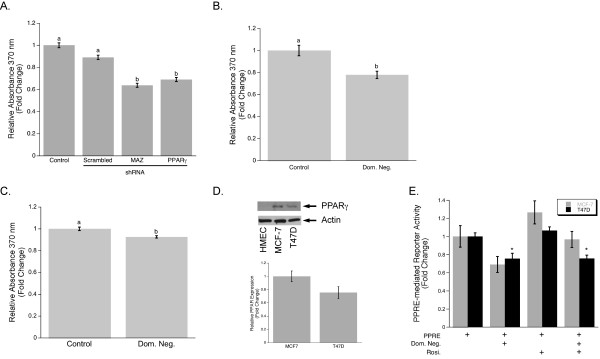Figure 3.
Decreased PPARγ1 expression is associated with a less proliferative phenotype for MCF-7 cells. A. Cell proliferation of MCF-7 cells transfected with or without scrambled, MAZ, or PPARγ1 shRNA was measured based on incorporation of the pyrimidine analog BrdU into DNA (BrdU proliferation ELISA). Data is shown as mean fold changes in cell proliferation compared to control cells. Error bars represent the standard error of the mean (s.e.m.) and the bars that do not share a letter designation were determined to be significantly different by Tukey's pairwise comparison (p < 0.05). B. MCF-7 cells were transiently transfected with a Δ462 expression plasmid or control plasmid. Cell proliferation was measured by BrdU proliferation ELISA. C. T47D cells were transiently transfected with a Δ462 expression plasmid or control plasmid. Cell proliferation was measured by BrdU proliferation ELISA. In Fig. B and Fig. C Student's t-test showed a significant difference (p < 0.01). D. The level of PPARγ1 expression in HMEC, MCF-7, and T47D cells was determined using Western blot analysis. Densitometry was used to quantify PPARγ1 expression in MCF-7 and T47D (n = 3). PPARγ1 expression in T47D is shown as a fold change in band intensity relative to MCF-7 cells. Intensity of each band was normalized to actin. E. PPRE-mediated reporter activity was measured by Luciferase assay in MCF-7 and T47D cells transfected with a dominant-negative mutant, Δ462, or control plasmid. Cells were also subsequently treated with 10 μM Rosi for 20 hours. Data is shown as mean fold change in cell proliferation compared to control cells. Error bars represent the standard error of the mean (s.e.m.). * Significantly different from appropriate control at p < 0.01.

